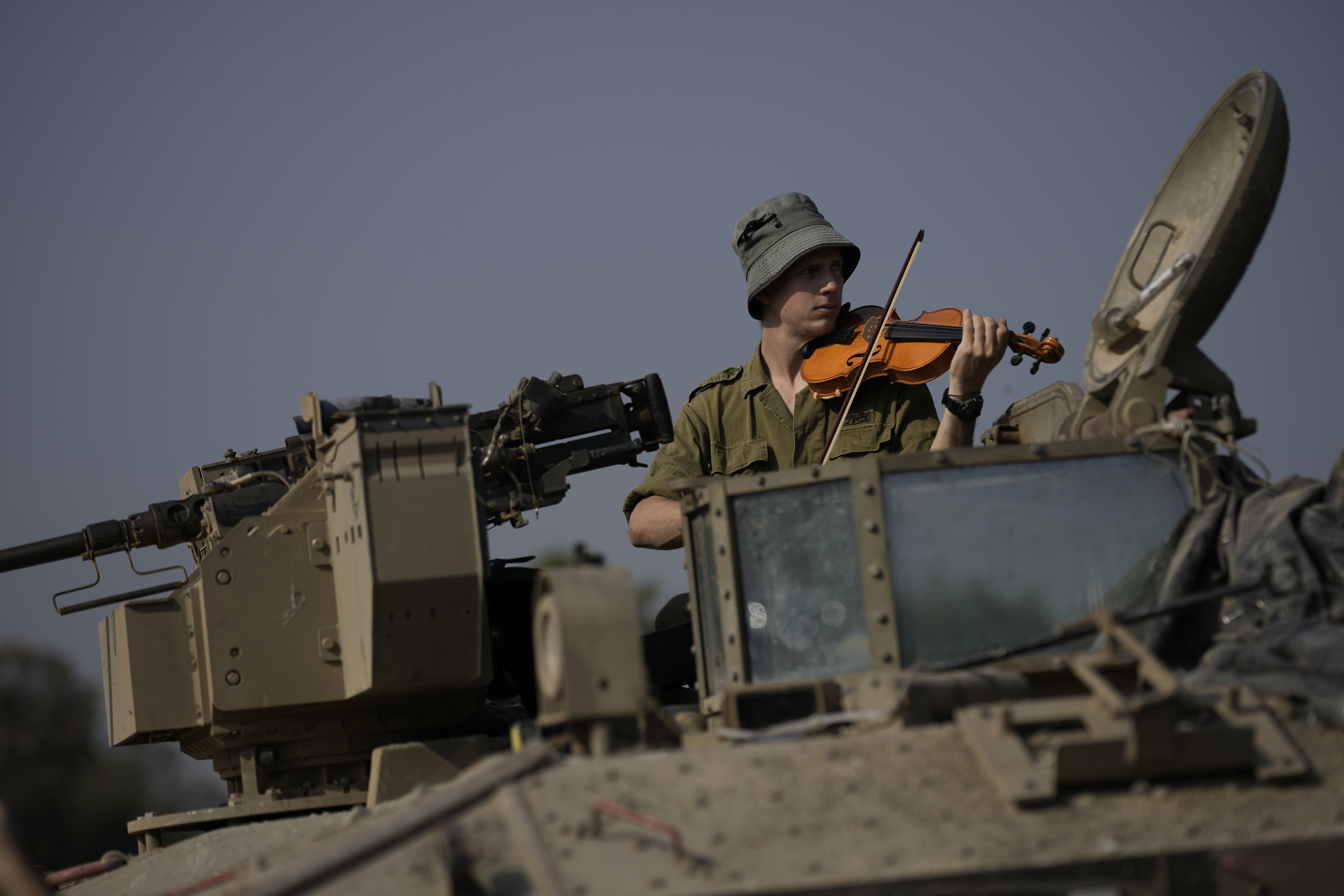US calls on Israel to reduce the intensity of Gaza war
‘Soon we will be able to distinguish between different areas of Gaza,’ the Israeli Defense Minister told his American counterpart, opening the door to the gradual return of displaced Palestinians

For more than two months, Israel has bombed Gaza by land, sea and air (at a rate unprecedented since World War II), reducing much of it to rubble and killing nearly 20,000 Palestinians, mostly children and women. Thousands more victims are estimated to be under the rubble, meaning the death toll is likely to be even higher. This is what has happened in the first two phases of the Israeli offensive launched in response to the October 7 Hamas attack, which killed 1,200 people in Israel and took more than 200 as hostages. The goal, according to Israeli Prime Minister Benjamin Netanyahu, is to “eliminate Hamas” — both politically (it has ruled Gaza since 2007) and militarily.
The United States has been financing, arming and diplomatically shielding — with its veto in the U.N. Security Council — Israel’s campaign, but is now encouraging Israel to move to a “third phase” to reduce the number of civilian casualties and the international pressure. On Monday, U.S. Secretary of Defense Lloyd Austin spoke with his Israeli counterpart, Yoav Gallant, about “how to transition from high-intensity operations to lower-intensity and more surgical operations,” as Austin declared in a joint press conference in Tel Aviv.
After last week’s public clash between U.S. President Joe Biden and Netanyahu, Austin did not want to sound like he was giving orders. “This is Israel’s operation, and I’m not here to dictate timelines or terms,” he said, adding that he had talked to Gallant about how to “reduce civilian casualties,” and discussed the status, goals and objectives of the campaign.
Austin also called for “urgent action” to stabilize the West Bank — since the start of the war, an average of three Palestinians die on every day at the hands of the Israeli army or Israeli settlers — and stressed that “Israelis and Palestinians both deserve a horizon of hope,” based on the two-state solution. “We know how hard that is, especially after October 7th. But ongoing instability and insecurity only play into the hands of Hamas,” said Austin on his second visit to Israel since the Hamas attack.
Israel and the United States are moving towards an agreement to change phase in January. Israel is also losing more and more soldiers, as hand-to-hand combat increases. Not only the massive long-distance bombardment and fire from armored vehicles, which reduces the risk of casualties, has been able to curb the recent rise in deaths. Israel announced on Monday that another five soldiers had died, bringing the number to 129.
At the press conference, Gallant said that the “war will take time,” but he suggested to Austin that he will fulfill the tacit pact to fully control northern Gaza next month. “I can tell you that soon we will be able to distinguish between different areas in Gaza,” said Gallant, arguing that this would open the door to the gradual return of displaced Palestinians (85% of the 2.3 million Gazans). “Maybe sooner in the north.” Few habitable homes remain in north Gaza, so residents will likely end up in shelters or tents. Some 60% of Gaza’s buildings are damaged or destroyed by bombing, especially in the north, according to United Nations estimates.
It is estimated that nearly one million residents in the north (almost all) have been forcibly displaced from their homes since October, by order of the Israeli armed forces. Today, they are living in crowded conditions in the south, where water and food are scarce, as evidenced by Sunday’s attack on a humanitarian aid truck in Rafah and the growing black market. The American NGO Human Rights Watch accused Netanyahu’s government on Monday of “deliberately” using hunger as a weapon of war against civilians in Gaza. The Gaza Strip also suffered a five-day telecommunications blackout, the longest of the war.
Hostage negotiations
The director of the CIA, William Burns, arrived in Warsaw on Monday to mediate a second exchange of hostages in Gaza for Palestinian prisoners. He met with the prime minister of Qatar, Mohammed bin Abdulrahman Al Thani (the main mediator); and with the head of Mossad (Israel’s intelligence services abroad), David Barnea.
Talks have regained momentum after Israeli soldiers mistakenly killed three Israeli hostages, despite the fact that they were waving a white flag, were not wearing shirts — to show that they were unarmed — and had hung messages in Hebrew from two windows (made with leftover food) asking for help. The military, however, believed it was a Hamas trap. The only Israeli hostage to survive the attack escaped to another building and shouted at the soldiers in Hebrew. They also thought it was a trap. He was shot down while going down the stairs.
An unidentified Israeli political leader, quoted by Israel’s state-owned Channel 12, underscored the need of presenting a proposal “that breaks the impasse” that negotiations reached after December 1, when the first and only hostage and prisoner swap of the war ended. During this period, there was a week-long cease-fire and an increase in the amount of humanitarian aid entering Gaza from Egypt.
With the Israeli army intensely attacking the north and south of the Gaza Strip, Netanyahu ordered Barnea to withdraw from the negotiating table, arguing it would be impossible for the two sides to reach an agreement. Now, the tone has changed. “If we are going to put a new proposal on the table, it has to be something that agitates [Hamas leader Yahia] Sinwar,” said the unidentified political leader. “It has to be a creative proposal in terms of the equation of what Israel asks for and what it is willing to give in exchange.”
The previous swap included only women and minors, both among the 80 Israeli hostages and among the 240 Palestinian prisoners. The number of hostages to prisoners was also much lower than in previous swaps. During the week-long cease-fire, Israel imprisoned more Palestinians than it released.
Now, Hamas — considered a terrorist organization by the United States and the European Union — wants to choose the names of the prisoners to be released and raise the price for each hostage. It is also calling for a partial withdrawal of Israeli troops, sources from the security forces of Egypt, the third mediating country, told Reuters.
Israel appears willing to release prisoners who would upset the far-right coalition partners in government. This includes prisoners “with blood on their hands,” who were convicted of murder or for having helped plan the attacks. Israel also opened its Kerem Shalom crossing with Gaza on Sunday to improve the flow of humanitarian aid into Gaza. This was one of the demands of Qatar and Egypt, as the Rafah crossing — designed for people, not goods — has been struggling to deal with the flow.
In the previous swap, most of the Palestinians released had not been tried and were charged with minor crimes, such as throwing stones or Molotov cocktails at soldiers and settlers, or vague offenses, such as “putting the security of the area at risk” or “exalting nationalist-based demonstrators.” A few dozen were serving sentences for attempted murder.
Genesis? Loop? Netanyahu seeks a name for the war

A few hours after the Hamas attack on October 7, when Israel was still trying to rebuild itself and did not fully control its territory (it took several days), the Netanyahu government began to bomb Gaza and, as usual, named the offensive: Iron Swords.
Two and a half months later, Netanyahu is looking for a name in line with the historical relevance of the war, according to local media. The government's main argument is that Iron Swords is only the operation (like others that Israel has launched in Gaza and that have lasted several days), but not the war. "He wants a name that is understood both nationally and internationally, so that people can remember the war as a significant one, and not just an operation," sources close to the prime minister told the information portal Walla.
Netanyahu threw out three possibilities Sunday at the weekly cabinet meeting, according to public television. Two are religious and refer to the beginning of the conflict. One is Simhat Torah War, the holiday in the Jewish calendar that ties in with the end of Sukkot, the date Hamas chose for its attack. On Simhat Torah begins the annual Bible reading cycle in Judaism, which explains the second option: War of Genesis, the first book of the Bible. According to the TV channel, Netanyahu believes it would resonate both within the country and with Christian audiences abroad. The evangelical movement, which places great importance on the reading of sacred texts, is for example a fervent supporter of Israel in general and Netanyahu in particular. And Genesis belongs to both traditions, since it inaugurates both the Hebrew Bible and the Christian Old Testament.
The third option is the Gaza War. It's a similar name given to the two conflicts in Lebanon, which began as an operation (Peace for Galilee, in 1982, and Just Reward, in 2006) and ended up being called Lebanon War.
Tu suscripción se está usando en otro dispositivo
¿Quieres añadir otro usuario a tu suscripción?
Si continúas leyendo en este dispositivo, no se podrá leer en el otro.
FlechaTu suscripción se está usando en otro dispositivo y solo puedes acceder a EL PAÍS desde un dispositivo a la vez.
Si quieres compartir tu cuenta, cambia tu suscripción a la modalidad Premium, así podrás añadir otro usuario. Cada uno accederá con su propia cuenta de email, lo que os permitirá personalizar vuestra experiencia en EL PAÍS.
¿Tienes una suscripción de empresa? Accede aquí para contratar más cuentas.
En el caso de no saber quién está usando tu cuenta, te recomendamos cambiar tu contraseña aquí.
Si decides continuar compartiendo tu cuenta, este mensaje se mostrará en tu dispositivo y en el de la otra persona que está usando tu cuenta de forma indefinida, afectando a tu experiencia de lectura. Puedes consultar aquí los términos y condiciones de la suscripción digital.
More information
Archived In
Últimas noticias
Most viewed
- Oona Chaplin: ‘I told James Cameron that I was living in a treehouse and starting a permaculture project with a friend’
- Reinhard Genzel, Nobel laureate in physics: ‘One-minute videos will never give you the truth’
- Sinaloa Cartel war is taking its toll on Los Chapitos
- Why the price of coffee has skyrocketed: from Brazilian plantations to specialty coffee houses
- Silver prices are going crazy: This is what’s fueling the rally










































